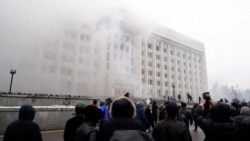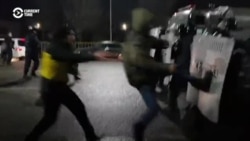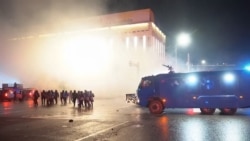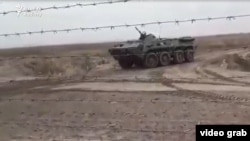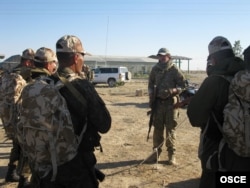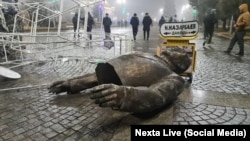
Tensions have been simmering in Kazakhstan for years, but no one thought a protest by dozens of people in the western city of Zhanaozen on January 2 would lead to massive nationwide demonstrations that ousted the prime minister and have protesters surging into government buildings and disarming police and soldiers.
But the doubling of fuel prices in Zhanaozen was just the trigger for the built-up desperation that Kazakhs feel after years of government corruption, bad economic conditions in a country rich in natural resources, and the absence of free and fair elections.
People in Kazakhstan had finally had enough of their authoritarian government's unfulfilled promises and lip service to real reform.
In spring 2016, many thousands of people demonstrated across Kazakhstan against the government’s land-privatization reforms that sparked rumors that land would be bought by foreigners, specifically Chinese.
But there were other issues.
One of the most prominent on the ever-growing list of demands by protesters was debt relief for those who had taken out hard-currency loans just before the government allowed the national currency -- the tenge -- to depreciate and lose half of its value.
WATCH: Video showed protesters storming City Hall in Almaty, the largest city in Kazakhstan, on January 5. After overwhelming police, they stripped them of their riot gear and made piles of shields and batons next to the building.
Added to that was bad inflation that occurred when the tenge fell from 182 to $1 to 340 tenge to $1 at the end of 2015, affecting nearly every Kazakh and adding to the number of people who came out to protest in spring 2016.
The government withdrew the land-reform proposal, worked with banks to lessen the burden on debt holders, and increased wages and social benefits.
But those changes only partially addressed people's problems.
In March 2019, Kazakhstan’s first and hitherto only president, Nursultan Nazarbaev, resigned and turned over leadership of the country to longtime friend and supporter Qasym-Zhomart Toqaev.
One of Toqaev’s first moves was to rename the capital, Astana, to Nur-Sultan in honor of Nazarbaev. He also named Nazarbaev's daughter, Darigha, as the speaker of the Senate, the second-highest post in the country.
Those moves angered many Kazakhs who thought the long reign of the Nazarbaev family was really over, prompting people to protest the new name of the capital and Darigha's lofty appointment.
The Kazakh words “shal ket” or “leave old man” have been heard increasingly in recent years in Kazakhstan.
There were protests again prior to and after the snap presidential election on June 9, 2019, as people again vented their frustration at the orchestrated change in leadership in which they played no part.
Even though Toqaev promised changes, Nazarbaev remained the major force in Kazakh politics in his new powerful role as secretary of the Security Council.
Perhaps most importantly, any attempts at reform by Toqaev continually fell short of what the people were hoping for.
The outbreak of the coronavirus pandemic provided the authorities with a reason to keep people from assembling for demonstrations.
But protests still took place before and after the January 10, 2021, elections to the Mazhilis -- the lower house of Kazakhstan’s parliament -- and the results of those undemocratic elections showed the same pro-government parties winning seats in a vote that opposition parties were largely kept from participating in.
Adding to the people's frustration of those staged elections is the fact that Kazakhs do not even get to vote for the members of the Senate.
It was telling that in Zhanaozen, where the recent protests started, officials sent by the government were scorned by the protesters and, in some cases, chased from the scene.
At about the same time, the term “kettling” entered Kazakhstan’s lexicon as police increasingly used the tactic of surrounding protesters and not allowing anyone to enter or exit an encircled area for any reason -- sometimes for many hours – in an effort to frustrate protesters.
A new law was passed on public rallies that fell far short of expectations as it obliged the prior approval of authorities for any gatherings and such approval was almost never given to groups planning to demonstrate against government policies.
Authorities instead started carrying out preemptive raids on activists and rally organizers, taking people into custody days ahead of demonstrations that were organized on social networks and holding them on spurious charges until the rallies were over.
Meanwhile, none of the socioeconomic problems the people were complaining about were ever fully resolved. Although some social benefits were improved, the people did not get everything they were demanding.
Prices for almost everything went up in 2021, sparking the largest number of worker protests and strikes in Kazakhstan in more than 20 years.
WATCH: Kazakh police used stun grenades in the early hours of January 5 as hundreds of protesters tried to storm the mayor's office in the country's biggest city, Almaty.
Striking employees were given small concessions to their demands, but they were not satisfied and often went on strike again.
When Nazarbaev stepped down, expectations were raised that Kazakhstan would embark on a new era in which people had a greater role in politics and their lives would noticeably improve. But nearly three years later, none of that has happened under Toqaev and the result is the current situation of mass protests by a frustrated populace.
Many people still find it difficult to make ends meet in a country that holds vast amounts of energy resources, and while they work hard, there have been more and more reports about the incredible wealth of Nazarbaev’s family and friends and the luxurious lives they lead.
And the political system continues to exclude the people.
Several opposition groups have tried to register new political parties, all without success.
It was telling that in Zhanaozen, where the recent protests started, officials sent by the government were scorned by the protesters and, in some cases, chased from the scene.
That happened in the summer of 2021, when officials from two pro-government parties went to meet with striking oil workers. They told them, “We are deputies whom you elected,” to which the striking workers replied, “You were named to your posts. The people did not elect you.”
Such sentiment seems to have washed over all of Kazakhstan.
The Kazakh words “shal ket” or “leave old man” have been heard increasingly in recent years in Kazakhstan and, if they referred specifically to Nazarbaev at first, they have come to mean the rigid system of governance Nazarbaev created during his 28 years as Kazakh president -- a system that has been maintained even without Nazarbaev officially at the helm.
The current protests -- unprecedented in scale for Kazakhstan -- are a popular expression of no-confidence in the government.
And it seems the half promises and partial concessions that officials are making to the Kazakh people will not work.






